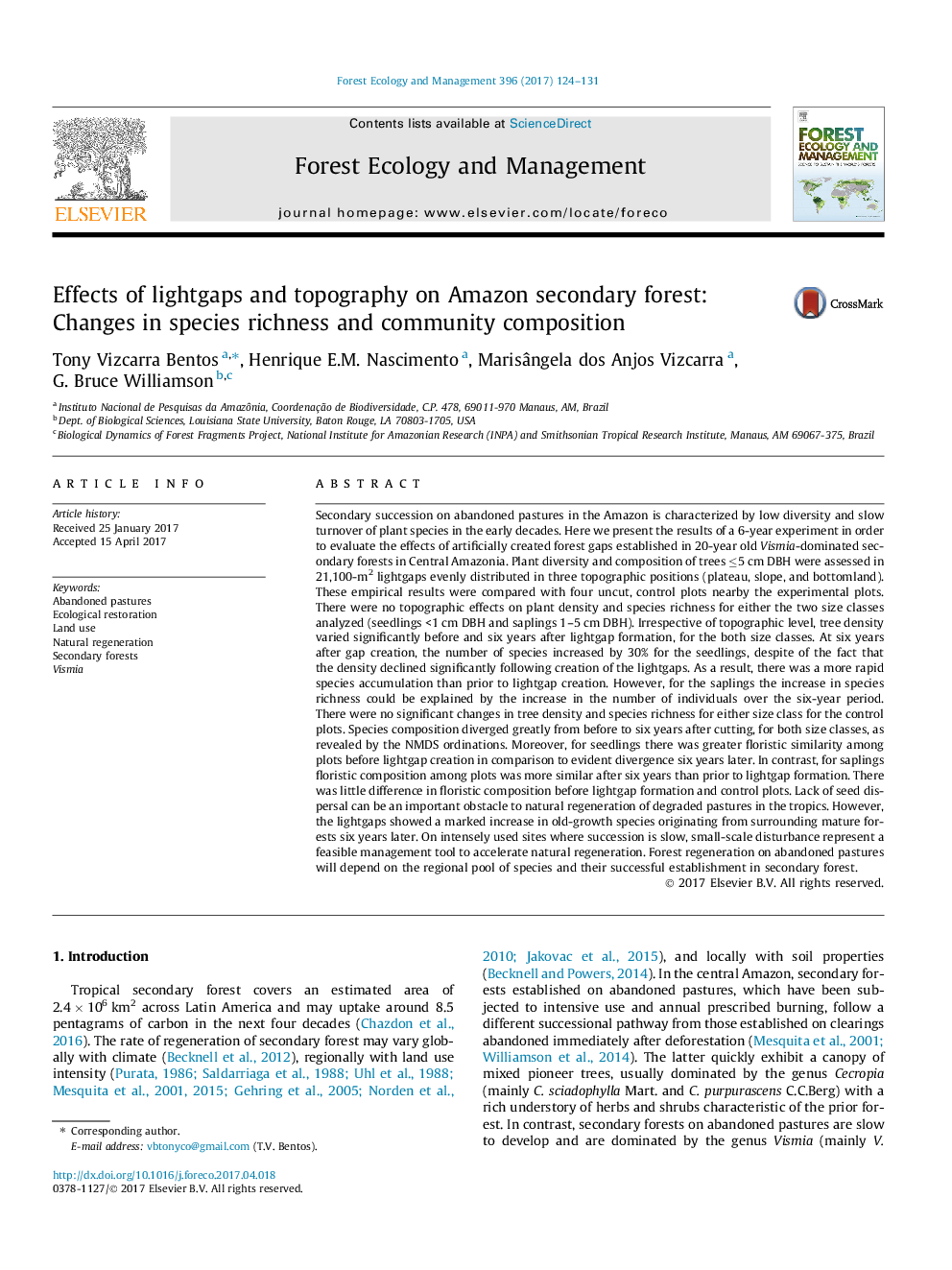| کد مقاله | کد نشریه | سال انتشار | مقاله انگلیسی | نسخه تمام متن |
|---|---|---|---|---|
| 4759422 | 1421362 | 2017 | 8 صفحه PDF | دانلود رایگان |
عنوان انگلیسی مقاله ISI
Effects of lightgaps and topography on Amazon secondary forest: Changes in species richness and community composition
ترجمه فارسی عنوان
اثرات نورپردازی و توپوگرافی در جنگل ثانویه آمازون: تغییرات در غنای گونه و ترکیب جامعه
دانلود مقاله + سفارش ترجمه
دانلود مقاله ISI انگلیسی
رایگان برای ایرانیان
کلمات کلیدی
مراتع ترک شده، بازسازی محیطی، استفاده از زمین، بازسازی طبیعی، جنگل های ثانویه، ویسمیا،
موضوعات مرتبط
علوم زیستی و بیوفناوری
علوم کشاورزی و بیولوژیک
بوم شناسی، تکامل، رفتار و سامانه شناسی
چکیده انگلیسی
Secondary succession on abandoned pastures in the Amazon is characterized by low diversity and slow turnover of plant species in the early decades. Here we present the results of a 6-year experiment in order to evaluate the effects of artificially created forest gaps established in 20-year old Vismia-dominated secondary forests in Central Amazonia. Plant diversity and composition of trees â¤5 cm DBH were assessed in 21,100-m2 lightgaps evenly distributed in three topographic positions (plateau, slope, and bottomland). These empirical results were compared with four uncut, control plots nearby the experimental plots. There were no topographic effects on plant density and species richness for either the two size classes analyzed (seedlings <1 cm DBH and saplings 1-5 cm DBH). Irrespective of topographic level, tree density varied significantly before and six years after lightgap formation, for the both size classes. At six years after gap creation, the number of species increased by 30% for the seedlings, despite of the fact that the density declined significantly following creation of the lightgaps. As a result, there was a more rapid species accumulation than prior to lightgap creation. However, for the saplings the increase in species richness could be explained by the increase in the number of individuals over the six-year period. There were no significant changes in tree density and species richness for either size class for the control plots. Species composition diverged greatly from before to six years after cutting, for both size classes, as revealed by the NMDS ordinations. Moreover, for seedlings there was greater floristic similarity among plots before lightgap creation in comparison to evident divergence six years later. In contrast, for saplings floristic composition among plots was more similar after six years than prior to lightgap formation. There was little difference in floristic composition before lightgap formation and control plots. Lack of seed dispersal can be an important obstacle to natural regeneration of degraded pastures in the tropics. However, the lightgaps showed a marked increase in old-growth species originating from surrounding mature forests six years later. On intensely used sites where succession is slow, small-scale disturbance represent a feasible management tool to accelerate natural regeneration. Forest regeneration on abandoned pastures will depend on the regional pool of species and their successful establishment in secondary forest.
ناشر
Database: Elsevier - ScienceDirect (ساینس دایرکت)
Journal: Forest Ecology and Management - Volume 396, 15 July 2017, Pages 124-131
Journal: Forest Ecology and Management - Volume 396, 15 July 2017, Pages 124-131
نویسندگان
Tony Vizcarra Bentos, Henrique E.M. Nascimento, Marisângela dos Anjos Vizcarra, G. Bruce Williamson,
